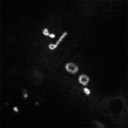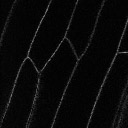|
|
This time series shows a detail of peroxisome dynamics. Some structures retain toroid morphologies and remain relatively stationary, while one organelle swims into the confocal plane as an elongated tubule, converts into a lasso-like shape and then into a torus. As a torus it hestitates in its movenment before converting to a tubule again and moving rapidly out of the plane of view. Note that the torus structures show periodic deformations at their edges that sometimes emerge as tubule-like projections. The frames were aquired at 0.75 second intervals, and are played back at 10 frames per second. The tag line shown is A5.
A hypothesis for this behaviour is that the tubule-like projections repesent an interaction with an underlying cytoskeletal network, an interaction that contributes to the deformation and to the motility of the organelle. The periodic deformations observed at the edges of the torus structures may represent transitory associations with this network. In animal cells, peroxisome motility has been shown to be dependent on the microtubule cytoskeletal system (Rapp et al, 1996). |
|
|

